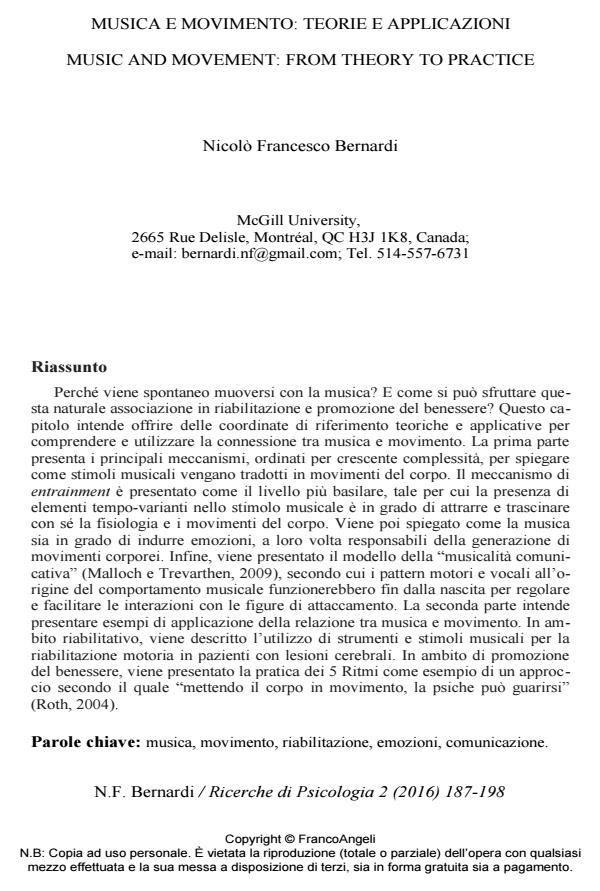Musica e movimento: teorie e applicazioni
Titolo Rivista RICERCHE DI PSICOLOGIA
Autori/Curatori Nicolò Francesco Bernardi
Anno di pubblicazione 2016 Fascicolo 2016/2
Lingua Italiano Numero pagine 12 P. 187-198 Dimensione file 178 KB
DOI 10.3280/RIP2016-002004
Il DOI è il codice a barre della proprietà intellettuale: per saperne di più
clicca qui
Qui sotto puoi vedere in anteprima la prima pagina di questo articolo.
Se questo articolo ti interessa, lo puoi acquistare (e scaricare in formato pdf) seguendo le facili indicazioni per acquistare il download credit. Acquista Download Credits per scaricare questo Articolo in formato PDF

FrancoAngeli è membro della Publishers International Linking Association, Inc (PILA)associazione indipendente e non profit per facilitare (attraverso i servizi tecnologici implementati da CrossRef.org) l’accesso degli studiosi ai contenuti digitali nelle pubblicazioni professionali e scientifiche
Perché viene spontaneo muoversi con la musica? E come si può sfruttare questa naturale associazione in riabilitazione e promozione del benessere? Questo capitolo intende offrire delle coordinate di riferimento teoriche e applicative per comprendere e utilizzare la connessione tra musica e movimento. La prima parte presenta i principali meccanismi, ordinati per crescente complessità, per spiegare come stimoli musicali vengano tradotti in movimenti del corpo. Il meccanismo di entrainment è presentato come il livello più basilare, tale per cui la presenza di elementi tempo-varianti nello stimolo musicale è in grado di attrarre e trascinare con sé la fisiologia e i movimenti del corpo. Viene poi spiegato come la musica sia in grado di indurre emozioni, a loro volta responsabili della generazione di movimenti corporei. Infine, viene presentato il modello della "musicalità comunicativa" (Malloch e Trevarthen, 2009), secondo cui i pattern motori e vocali all’origine del comportamento musicale funzionerebbero fin dalla nascita per regolare e facilitare le interazioni con le figure di attaccamento. La seconda parte intende presentare esempi di applicazione della relazione tra musica e movimento. In ambito riabilitativo, viene descritto l’utilizzo di strumenti e stimoli musicali per la riabilitazione motoria in pazienti con lesioni cerebrali. In ambito di promozione del benessere, viene presentato la pratica dei 5 Ritmi come esempio di un approccio secondo il quale "mettendo il corpo in movimento, la psiche può guarirsi" (Roth, 2004).
Parole chiave:Musica, movimento, riabilitazione, emozioni, comunicazione.
Nicolò Francesco Bernardi, Musica e movimento: teorie e applicazioni in "RICERCHE DI PSICOLOGIA " 2/2016, pp 187-198, DOI: 10.3280/RIP2016-002004